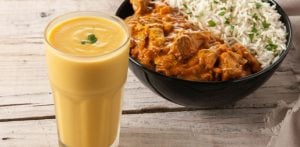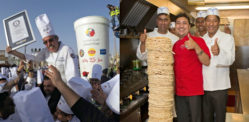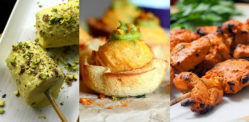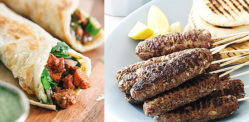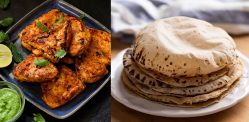the perfect dish for an Indian wedding.
Indian weddings boast a lavishness and vibrancy in every aspect. Yet, the true heart of this celebration can often be found within the homely aromas radiating from the buffet table.
What better way to celebrate the union of families than by sharing the same hearty meals enjoyed with siblings.
That is exactly why comforting, familiar favourites resurface on Indian wedding menus time and time again.
From the briyanis of Hyderabad to the creamy dals of Punjab, these dishes have solidified themselves as wedding staples.
Here are 10 must-have dishes at an Indian wedding.
Biryani

When it comes to family favourites, biryani comes to mind.
A regal and diverse dish with dozens of regional variations, biryani is the perfect dish for an Indian wedding.
It can easily accompany a wide range of other main and side dishes.
Fundamentally, this dish consists of aromatic basmati rice slowly cooked alongside a choice of either vegetables or meat.
The primary spice mix includes cardamom, cloves, bay leaves, turmeric, cumin and garam masala, amongst many others.
No matter the taste preferences, biryani is always a popular choice at Indian weddings.
Paneer Butter Masala

Though the chicken variation has garnered more international attention, the softer and lighter paneer masala has an everlasting legacy.
Its duality in accommodating both vegetarian and non-vegetarian diets within the expansive guest lists also makes it a more practical choice for weddings.
The layered blend of sweetness from the tomato puree, cream, and onions adds a refreshing variety against the savoury notes of the other main courses.
Everyone will instantly be drawn to the easily identifiable vibrancy that this classic dish adds to the wedding buffet.
Dal Makhani

This dish’s origins can be traced to the Western Punjab region pre-partition, now known as Peshawar in Pakistan.
Brought to India by Peshawari refugees, it quickly became a widespread favourite in the region.
Consisting of black lentils and kidney beans, the components of this dish produce a thick, rich consistency.
Such wholesome ingredients also make dal makhani an excellent source of both protein and fibre. In turn, it serves as a hearty and filling wedding option to satisfy the numerous hungry guests.
It is traditionally simmered overnight, often in clay pots, with the slow cooking bringing out deep and smoky flavours.
This culminates in a dish that will leave anyone content long enough to enjoy the energised dancing and festivities.
Malai Kofta

This North Indian classic acts as a more substantial addition to the vegetarian mains often featured in wedding spreads.
Malai kofta provides a more varied textural alternative to the creamy and velvety curries traditionally seen at Indian weddings.
Rather than meat, these kofta balls are made using paneer and potatoes, with the optional inclusion of other vegetables within the mixture.
This texture is further layered by the addition of nuts and raisins. These are then deep-fried before being added to a familiar creamy ‘Malai’ base.
These crispy dumpling-like meatballs thus culminate in an explosion of flavours and textures.
From savoury to sweet and soft to crunchy, this dish truly captures the vast range of Indian cuisine, perfect for weddings.
Sambar

This South Indian, lentil-based vegetable stew offers a more sour and tangy flavour profile in the wedding menu.
It owes this flavour to tamarind and various spices.
The flavour is nicely balanced with a serving of rice or idli.
Sambar is often featured in Tamil, Telugu, and Kannada wedding feasts. It is not just a side dish, but an essential corner-piece of traditional South Indian cuisine.
It pairs beautifully with other staple condiments and relishes like coconut chutney, thogayal or pachadi.
Sambar is believed to have originated in 17th-century Thanjavur, Tamil Nadu. Supposedly, a royal cook mistakenly replaced the kokum of a traditional Maharashtrian dish with tamarind, creating the happy accident of sambar.
Avial

Like sambar, avial also offers a tangy punch.
It consists of a unique mixture of vegetables such as plantain, carrots, aubergine, cucumber and snake gourd.
These are then cooked with a blend of coconut and yoghurt.
These vivid flavours ultimately create a sensational sweet and sour punch to wake up the taste buds.
Originating from Kerala and Tamil Nadu, avial is believed to have been created by Bhima of the mighty Pandavas.
Supposedly, whilst disguised as a cook, Bhima compiled the various ingredients and vegetables he could find and boiled them.
He then added some grated coconut, thus creating the first avial.
And ever since, it’s become a popular dish within South Indian cuisine, essential to all major festivals and celebrations, especially weddings.
Both avial and sambar accompany sadhya and Faizal explains that in South India, sadhya is “a must-have for weddings, especially”.
However, he added: “If you miss sambar or avial in your sadhya, people don’t even consider it as sadhya.”
Ras Malai

An iconic dessert within Indian cuisine, ras malai is a staple sweet treat on Indian wedding menus.
Ras malai is made from chhena discs, which are cooked in a sugar-water mixture. They are then soaked in milk mixed with some or all of saffron, pistachios, rose water, or cardamom.
This dessert has fragrant floral notes, and the milk prevents it from being too sweet, making it the ideal post-dinner treat at a wedding.
Jagjot says ras malai is essential at Indian weddings because “it’s usually served cold and after hot, spicy
food to cool the mouth down”.
This rich yet calming sweetness has resulted in rasmalai often being seen as symbolising all things sweet, joyous and prosperous.
On this symbolism, Jagjot said: “It’s very important in Desi cultures to make sure, in happy occasions, to give people sweet things to celebrate.”
With this combination, it’s no surprise that ras malai is a must-have dessert at an Indian wedding.
Chole

Chole is a wedding buffet favourite and perhaps the most sought-after dish despite its relatively simple ingredients.
Requiring patience, this dish is cooked over a long period of time in large iron pots. It is often viewed as a dish symbolising resilience and abundance.
One reason why chole is a must-have at weddings is that it is mildly spiced in comparison to other dishes. This makes it perfect for guests who may struggle with the spicier options.
The chickpeas are cooked until tender, then simmered in an aromatic gravy. It is usually paired with fried bread.
This combination makes it especially popular at Punjabi weddings.
This dish packs a slightly tangy punch, thanks to dried mango powder.
The aroma upon lifting the lid alone can get everyone off the dance floor and straight to the dining table.
Gulab Jamun

Though often labelled as the ‘doughnuts of South Asia’, gulab jamun holds a far more significant place within Indian cuisine.
Gulab jamun’s universality allows it to weave effortlessly into grand celebrations and quiet evenings with a cup of chai.
These deep-fried dough balls are made from khoya and soaked in a fragrant sugar syrup. Their flavour profile is reminiscent of ras malai: rich with cardamom, saffron and rose water.
Its origins are deeply tied to Persian and Central Asian influences. They were later adapted in the Mughal kitchens to create this simple yet beloved treat.
The combination of sweetness and lightness has since turned gulab jamun into a delectable dessert at weddings.
Samosa

Samosas are the bread and butter of any festivity and Indian weddings are no exception.
They are one of the most dynamic snacks, enjoyed as a starter or as a light treat whilst on the dancefloor.
Samosas are believed to have originated in the Middle East and Central Asia.
Crispy pastry encases a lightly spiced filling of either meat, potatoes or vegetables.
This versatility ensures that there is something to satisfy the pickiest of eaters.
After all, there’s nothing like holding a warm samosa in one hand whilst chatting away during a wedding function.
These aren’t just popular wedding dishes; they’re the backbone of the celebration.
From the creamy richness of paneer butter masala to the nostalgic aroma of chole, each dish brings people together in the most joyful way.
They create moments, whether it is between friends catching up over starters or families bonding over dessert.
Indian weddings are grand, emotional, and unforgettable. And so is the food.























